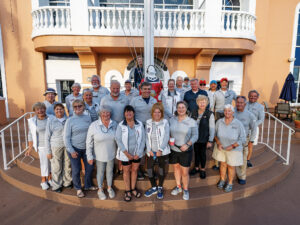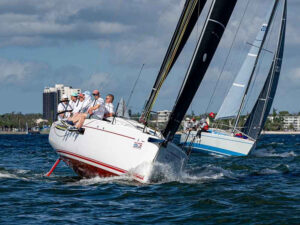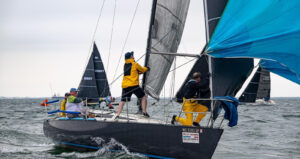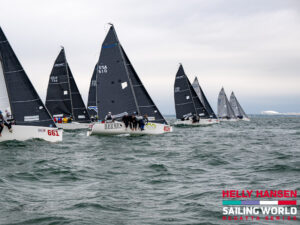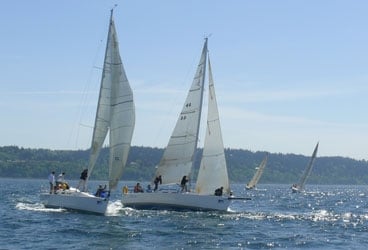
SeattleNOODweb2
“It was actually pretty straightforward,” Bob Pistay, the skipper of the Melges 24 Fast Forward tells me when I ask him to sum up his top finishes on the day. “Avoid the current out in the middle and go for the breeze on the right.” That, of course, was easier said than done for the rest of the boats in his class, which followed him around Puget Sound for the first two races of the day. He and his crew of regulars, locals who apparently know the waters of Puget Sound well enough, racked up a pair of firsts and followed up with a fourth in the day’s third race to put the team squarely in the lead on the opener of the inaugural Sperry Top-Sider Seattle NOOD.
And what an opener it was. The sun made its appearance as forecast, and the wind was already sweeping down the Sound when everyone showed up to rig for the first day of racing. The breeze was a solid 8 to 12 knots, and save for a few subtle shifts of the starting marks, the breeze was dead-nuts consistent, leaving race committees with little to do but fire off races and take finishes on two race circles. The same predictability couldn’t be said of the current, however, and there was lots of it. Sometimes it seemed there was more of it on one side than the other. The best teams, however, figured out the deceivingly simple conditions without much trouble, and a passing glance down the standings of the classes competing today confirms that many of the top performers were indeed home teams or regulars to Puget’s deep, fast-moving water; teams like perennial Thunderbird class standout Predator, campaigned by local ace Craig Burnell.
“It’s a fast boat, especially in a breeze,” was all I could cajole out of Burnell when I pressed him to reveal what he knew of the local conditions and what it is exactly that makes his hard-chine machine go so fast. He was smart enough to keep the secrets to himself and gracefully slipped away and to leave his wife Kathyrn Lategan to do the talking. “It’s not only the boat, which is actually very fast. It’s Craig and the rest of the crew and it’s his foredeck person [herself],” she says with a laugh. “But really, the most important thing is we’ve sailed with much of the same people and have others that we can rotate in that are very good.”
With eleven of these funky native one-designs on the line-many with teams that have been sailing together in some way, shape, or form for many years-having a good crew goes a long way, and the close racing on the water today proved, as it always does, that in the end those who know the boat best regularly come out on top, even if only by a boatlength or two. Predator, Lategan points out, has been the “Top Bird” in the regional rankings for more times than the fingers on her right hand (she does have five by the way.) But Lategan herself will be sitting out the rest of the series, leaving Burnell a major handicap in the foredeck department, perhaps opening the door for his Thunderbird rivals on Invader and Water Torture, both within easy striking distance in the standings. “There was some close calls with these two boats today,” says Lategan. But she has the utmost confidence her skipper will keep the streak alive. “He’s good, very good.”
With the Seattle NOOD Regatta being the first major keelboat one-design regatta in the region in recent memory, many teams are enjoying their first taste of local one-design class competition, and that includes the two larger (in overall length) classes, such as the C&C 115 and Beneteau 36.7. “It’s definitely the first time we’ve sailed together as a fleet,” one crewmember of Carl Freund’s Veloce, the leading 36.7, tells me as he waits patiently in line for his rum fill-20 or so bodies deep. “It was really tight racing though, especially at the starts, and then everyone tended to spread out as the races went on, but there were packs that stayed together to keep it close.” When pressed to reveal more about what worked for his team, he could only offer, “I don’t know.” Something tells me he did know, but at this early stage in the regatta, he wasn’t quite ready to reveal it.
As this writing there were a few protests yet to be heard, but the provisional results of the day can be found here. The regatta’s dinghy and multihull sailors join in tomorrow, so check this space for more to come.

